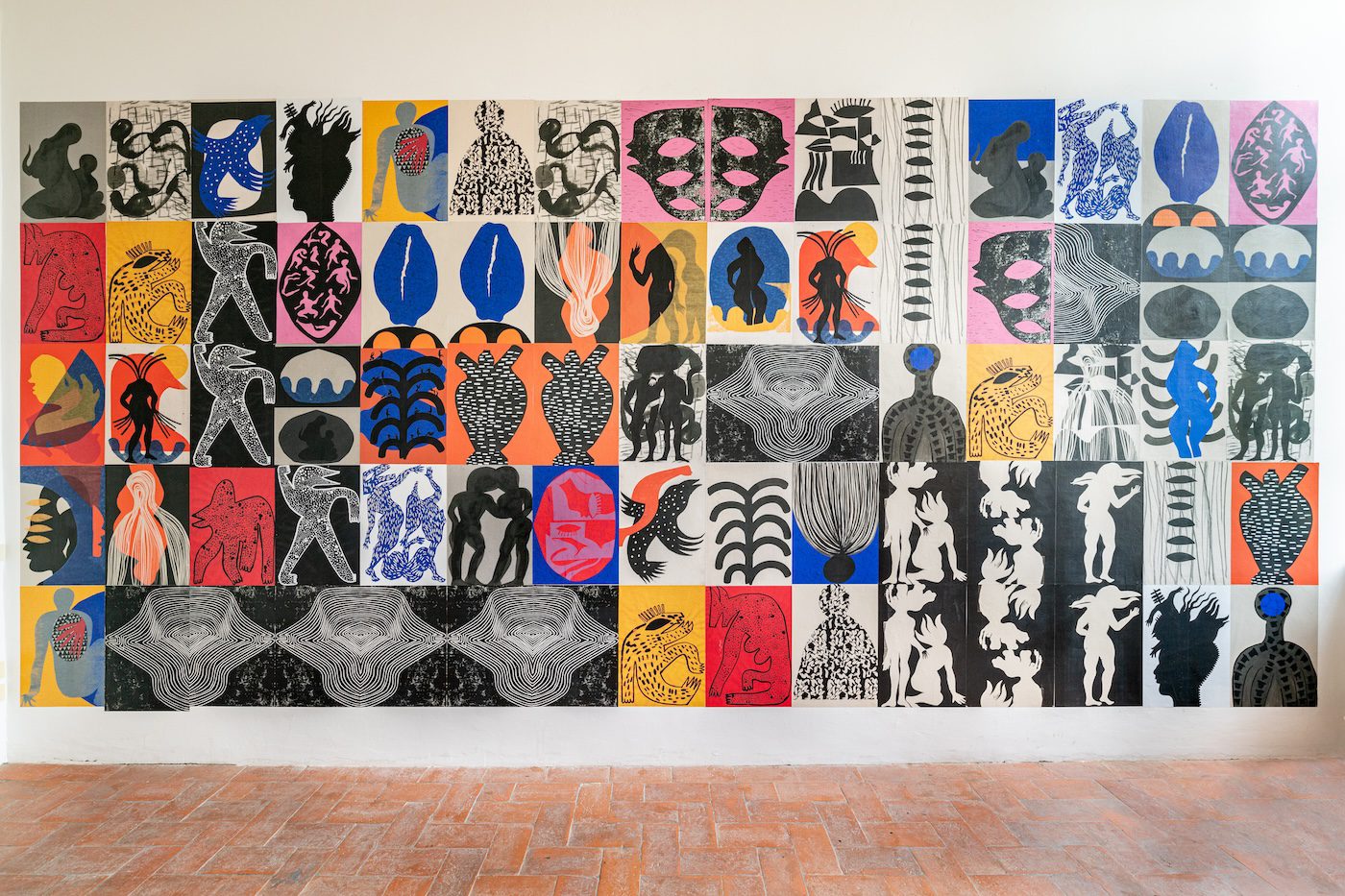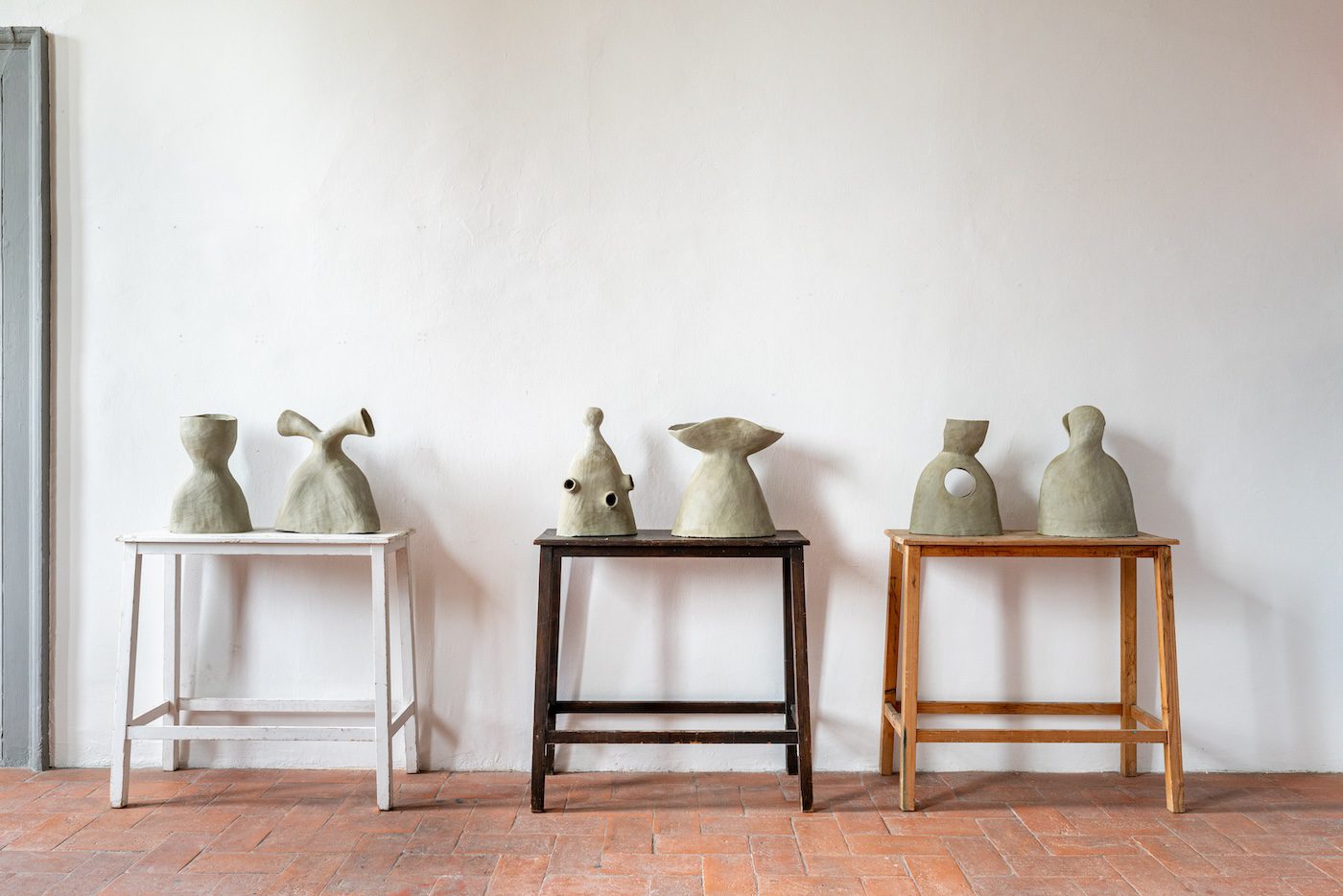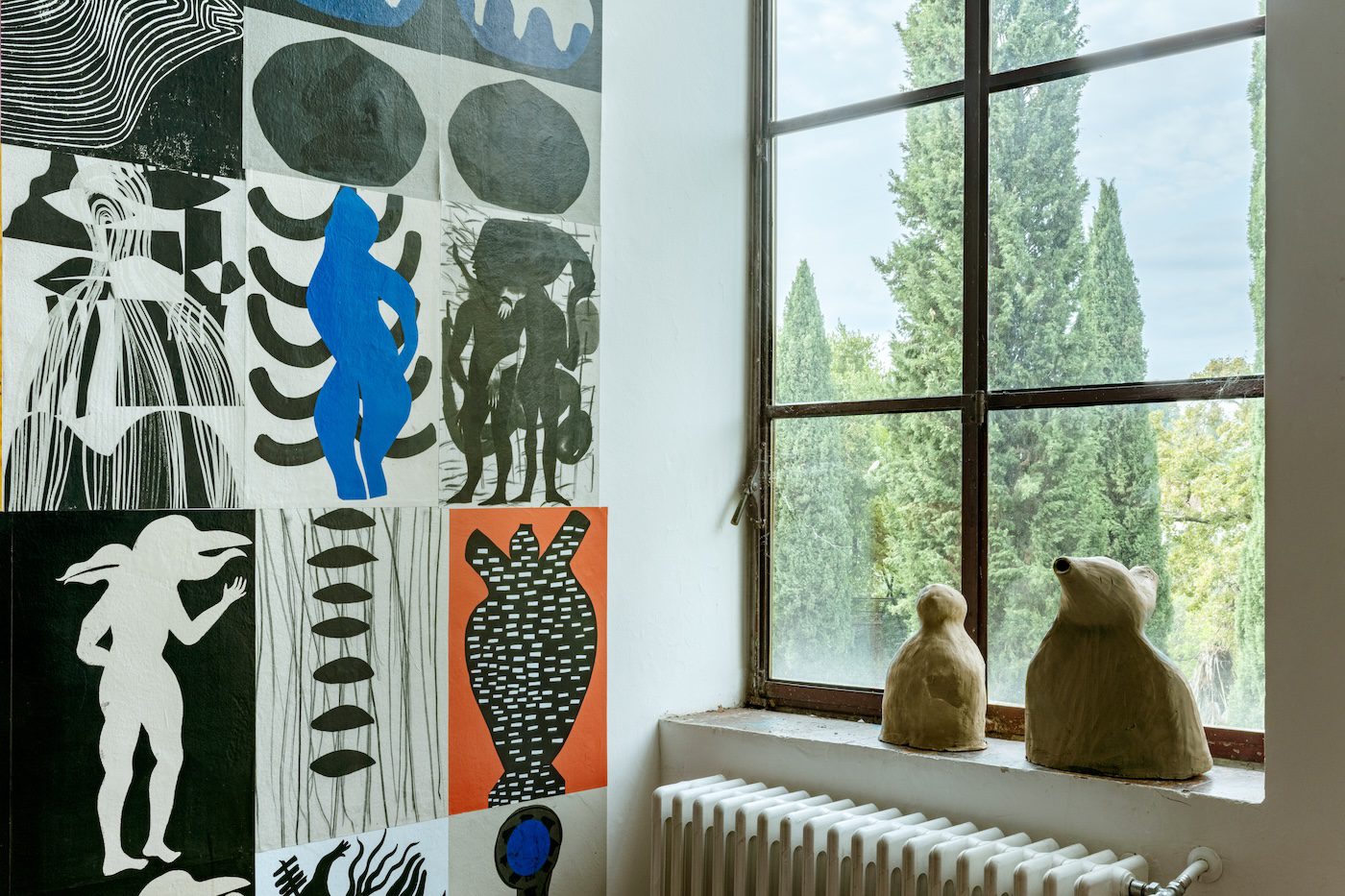We spoke to artist Diana Ejaita about her residency at the Villa Romana, her multidisciplinary work, and the many uses of symbols and images.

Diana Ejaita, Studio Villa Romana ©photo Ela Bialkowska OKNO studio.
Contemporary And: Diana, congratulations on the Villa Romana Prize 2023! Can you talk about the work you’ve created during the residency and how it felt to reconnect to Italy?
Diana Ejaita: Thank you! It was a wonderful surprise that arrived at the right moment in life.
When Chiara Figone (Archive Books) and Elena Agudio (Villa Romana Florence) called to tell me I was selected as one of the fellows for 2023, I was astonished. I was grateful to be able to move with my one-year-old daughter to Italy, with enough support to work and be a mom in a green, spacious, and welcoming space.
Moving to Villa Romana in March, I remembered the day I left Italy at nineteen, almost twenty years ago: it was such good feeling to take my luggage and go. I was sure that the country I was born in could not offer enough for me to peacefully develop into the person I wanted to be. As an Italian born with Nigerian origins, I needed more than being in a place where I felt I had to justify on a daily basis my right to be a young Black Italian woman. It is tiring to be limited by preconceptions of who and what one is supposed to be. Prejudices are a suffocating virus. The normalization of daily racism also hindered and disturbed peaceful self-development (and still does) . At that time, Berlin offered that space to breath and to be, to experience and to grow.
Coming back this year, it was interesting to see how much has naturally changed. I already knew but I was grateful to see how second-generation Italians are shaping the space to be more comfortable for them. Despite the politics and the horrific, vulgar mainstream attempt to keep people blind, there are so many fights, strengths, beautiful things, and positive stories to listen to. It was good to be home, a foreigner at home. Or at one of many homes.
Villa Romana offered a quiet space of reconciliation. It has been an honor to be with the very first fellows to celebrate the residency’s new direction. I worked on different projects: an installation for Haus der Kulturen der Welt as well as some ceramic work, some silkscreen and etching. But I also managed to finish two children’s books – they’ll be out in March!

Diana Ejaita, Studio Villa Romana ©photo Ela Bialkowska OKNO studio.
C&: You are what we call in German a Tausendsassa. What was your journey into the arts and how did your many ways of telling stories come alive?
DE: I was a dancer for many years as well as a singer. In my twenties I was part of a band between Berlin and Holland, a group of musicians and performers from all over the world. Everything was about improvisation, and it was very political and spiritual at the same time. None of us were professional, so to make things work we really had to listen to each other and be very present mentally, spiritually, and physically. I think from that I built a sense of understanding that if we fuse with something we can see how to manage it. That five-year experience gave me a lot of freedom of spirit – I understood that nothing is impossible, that I could break the limitations created by fear. Then I moved into printmaking and drawing. I worked a lot for many years, for myself but also to one day be able to share stories with people. Making art to me is powerful healing – only later did I understand I could make work out of my passion. I’ve never been moved by ambition. Creating is like breathing. It all started with interrogating my own experience as a woman with different cultural backgrounds and the dynamics of migration, racism, and colonial disaster; while researching, I responded through textile, printing, and drawing.
I love to listen to people telling stories. For many years I recorded people singing lullabies; I would meet them while travelling, for example. I started again in Burkina Faso, recording a good friend reading or simply narrating traditional stories during our long walks.

Diana Ejaita, Studio Villa Romana ©photo Ela Bialkowska OKNO studio.
C&: How do the ceramics and the two-dimensional work come together?
DE: They complement each other; one continues the sentence of the other. As the work evolves with my present life experience, what I do is a modulation, through creation, of the experience of passing years in the evolving time we live in. The work fuses past, present, and future. Maybe the ceramics or the bronzes decide to come out from a bidimensional image to explore the space. To me, both are very lively creatures.
C&: The vivid pattern you created at Villa Romana out of many individual human and non-human shapes seams to challenge the porosity of the architecture. How do architectural power dynamics enter your work?
DE: Bodies, Tales, Landscapes (2020–ongoing) started in Burkina Faso during a residency at Operndorf Africa curated by Akinbode Akinbiyi. The piece I worked on at Villa Romana is an evolution of it, sparked by a reflection I had on metamorphosis and the fact that our bodies are strictly connected with the landscape, the space surrounding us, and tales, the old narrations and the new ones.
Each moment we live and move in is part of constant metamorphosis. Tales and narrations represent our evolving knowledge and that which we carry within our bodies through ancestral cognitions. We are in constant movement between present, past, and becoming, some of it unconscious as we carry the spirits of our ancestors. If we are lucky enough to be able to listen the depth of human experience, we have infinite material to work with. Bodies, Tales, Landscapes is then a combination of visions and symbols, each standing for itself but needing the others to evolve and speak. I call the work a syllabus or an alphabet, where the letters are images that can be displayed in different ways next to each other. They are unfixed and can combine by adapting to different spaces and times. They can compose a harmonic narrative or improvised poetry. There is no rule, but their togetherness creates an unfixed story, a temporary feeling. I like the movement it creates and the fact that there is not really a beginning or an end but moments and interconnected worlds.

Diana Ejaita, Studio Villa Romana ©photo Ela Bialkowska OKNO studio.
C&: Can you elaborate on that?
DE: When I draw symbols, it happens in a kind of meditative moment where I try to connect to my spiritual knowledge. I believe we carry knowledge through which, if we try to explore the deepness, we can get to the basics and find quite “primitive” traits. I try to control as little as I can, and I try to be vulnerable and honest. The language that comes out of it is quite simple and intuitive. I try to do something that could speak to anyone in a very immediate way. I truly believe that at the core we all come from the same thing and that if we find the right language, we can truly easily feel the connectivity. Language is more than the word: it is made of emotions, intuitions, observation, movement, textures, or sound. Even if the material product is visual, it tries to concentrate these elements and give signs of it or allow sparks of ideas.
C&: You are also an illustrator and make artwork for books, mostly children’s books but also magazines and newspapers. How do you approach that work?
DE: I thought my personal projects had a very defined style – starting to work as an illustrator moved me to break that comfort zone and push toward new possibilities. I had to develop a way of doing that was more approachable and I moved from strictly black-and-white work to extremely colorful images. I thought I could give voice to colors at that point. In recent years I’ve learned to be very fast in reading articles and finding a visual solution, working for magazines such as the New York Times, the Washington Post, or the Economist. Often I have to respond with an image in less than twenty-four hours. It’s been a huge exercise to problem-solve so quickly. I was lucky to have the chance to learn this new skill.
Illustrating made me understand how images are consumed as products. It took a way a little of the mystical element, but I am enjoying seeing how far an image can go and in how many ways it can be used: information, education, product design, and so on.
The illustrations for children book came from my very first cover for The New Yorker. My publisher Rise Books from Penguin Random House invited me to create a first book for kids: Olu and Greta. After four years I will have written and illustrated or collaborated on a total of eight children’s books with incredible writers such as Ben Okri, Aracelis Girmay, and Bunmi Emenangio.
A recent illustration-related work is for Deutsche Bahn: a permanent work installation at an S-Bahn station in Berlin – the exact location to be revealed in a couple of months!
Interview by Julia Grosse & Theresa Sigmund.
More Editorial